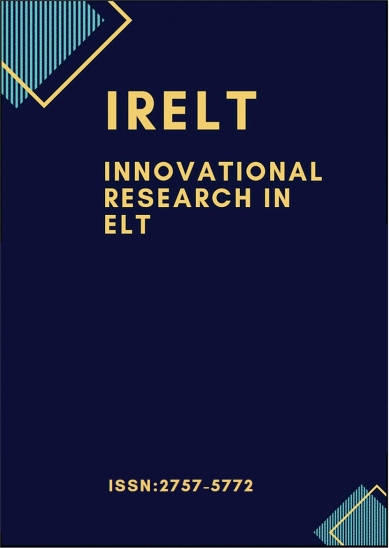Research article | Open Access
Innovational Research in ELT 2021, Vol. 2(1) 31-43
Native and Non-native EFL Teachers' Burnout: No Isolation but Cooperation
pp. 31 - 43 | DOI: https://doi.org/10.29329/irelt.2020.347.4
Publish Date: June 07, 2021 | Single/Total View: 217/953 | Single/Total Download: 282/2.202
Abstract
The aim of this study is twofold: to investigate the burnout levels of native and non-native ELT teachers, and to account for the reasons behind the most stressful aspects of being an ELT teacher in an EFL context.
Employing a mixed method design method, 30 ELT teachers are divided into two groups;15 native and 15 non-native. The data is collected using the Maslach Burnout Inventory Educators Survey online to find out the burnout levels within the three components- emotional exhaustion (EE), depersonalisation (DP) and reduced personal accomplishment (RPA), and the levels of the two groups are compared to find out whether there is any difference. The procedure also includes online interview to find out the reasons for burnout. The findings revealed that there is a difference between the two groups; where there is ‘low' burnout level of non-native teachers, the scoring indicated a ‘high' level for native teachers. Content analysis of online interview data indicated hardness of contextual patterns, which are working, interaction and EFL teaching; in contrast, the analysis of non-native teachers' data indicated positive consideration of EFL teaching and having an increasing interest in post-graduate degrees in education. Implications are discussed, one of which might be the same as what the title of this research study says: no isolation, but co-operation with the two.
Keywords: Native EFL teachers, non-native EFL teachers, emotional exhaustion, depersonalisation, reduced personal accomplishment
APA 7th edition
Subasi, S. (2021). Native and Non-native EFL Teachers’ Burnout: No Isolation but Cooperation. Innovational Research in ELT, 2(1), 31-43. https://doi.org/10.29329/irelt.2020.347.4
Harvard
Subasi, S. (2021). Native and Non-native EFL Teachers’ Burnout: No Isolation but Cooperation. Innovational Research in ELT, 2(1), pp. 31-43.
Chicago 16th edition
Subasi, Simge (2021). "Native and Non-native EFL Teachers’ Burnout: No Isolation but Cooperation". Innovational Research in ELT 2 (1):31-43. https://doi.org/10.29329/irelt.2020.347.4
Anderson, B.G., &Iwanlcki, E.F. (1984). Teacher motivation and its relationship to burnout, Educational Administration quarterly, 20, 109-132.
Ar, K. (1998). The sentiments of EFL teachers at Turkish Universities. Unpublished master’s thesis, Bilkent University, Ankara.
Brewer, E. W., & McMahan, J. (2003). Job stress and burnout among Industrial and Technical teacher educators. Journal of Vocational Education research, 28(2).
Brown, P. L., III. (2009). A comparison of burnout rates between part-time and full-time postsecondary educators at a community college (Unpublished master’s thesis). Retrieved from http://etd.ohiolink.edu
Canagarajah, A.S. (1999). Interrogating the “native speaker fallacy”: non-linguistic root, non-pedagogical results. In G. Braine (Ed.). Non-native educators in English language teaching (p. 77-92). Mahwah, NJ: Erlbaum.
Cherniss, C. (1980). Staff burnout: Job stress in the human services. Beverly Hills, CA: Sage Publications, Inc.
Corcoran, K. J. (1985). Measuring burnout: A reliability and convergent validity study. Journal of Social Behavior and Personality, 1(1), 107-112.
Çoşkuner, M (2001). Turkish provincial state university teachers’ perceptions of English language teaching as a career. Unpublished master’s thesis, Bilkent University, Ankara.
Davies, A. (1991). The native speaker in applied linguistics. Edinburg: Edinburg University Press.
Davies, A. (2003). The native speaker: Myth and reality: Great Britain: Cromwell Press.
Dubbeld, A., Natascha de Hoog, Perry den Brok&Maarten de Laat (2019). Teachers’ Multicultural attitudes and perceptions of school policy and school climate in Relation to burnout, Intercultural Education, 30:6, 599-617
Freudenberger, H.J. (1974). Staff burn-out. Journal of Social Issues, 30(1), 159-165.
Ginsburg, S.G. (1974). The problem of the burned out executive. Personel Journal, 53(8), 598-600.
Hamilton, K. (2005). Getting off the burnout track? Diverse issues in Higher Education, 22(20), 26-31.
Kaplan, R.B. (1999). The ELT: Ho(NEST) or not ho(NEST)?NNEST Newsletter, 1, 1, 1 & 5-6.
Karagöl, K. (1997). Job satisfaction of English native speaking teachers in İstanbul.Unpublished master’s thesis, Marmara University, İstanbul.
Lee, R.T., &Ashforth, B. E. (1990). On the meaning of Maslach’s three dimensions of Burnout. Journal of Apllied Psychology, 75(6), 743-747.
Maslach, C. &Jackson, S.E. (1981). The measurement of experienced burnout. Journal of Occupational Behavior, 2, 99-113.
Maslach, C., Jackson, S.E., & Leiter, M.P. (1996). Maslach burnout inventory (3rd ed.). Mount View, CA: Consulting Psychologists Pres, Inc.
Maslach, C. & Pines, A. (1977). ‘The burn-out syndrome in the day care setting’, Child Care Quarterly. 6. 100-413.
Medgyes, P. (1992). Native or non-native: Who’s worth more? ELT Journal, 46, 340-349
Medgyes, P. (1999). Language training: A neglected area in teacher education. In G. Braine (Ed.). Non-native educators in English language teaching (p. 177-195). Mahwah, NJ: Erlbaum.
Medgyes, P. (2001). When the teacher is a non-native speaker. In M. Celce-Murcia Teaching English as a second or foreign language. (p. 429-442). Boston: Heinle and Heinle.
Silviyanti, T. M., Gani, S. A., &Junita, D. (2021). The native English teachers’ expectations in teaching EFL students. Studies in English Language and Education, 8(1), 212-226
Swales, J. (1993). The English language and its teachers: Thoughts, past, present, and future. ELT Journal, 47, 283-291.
Tumkaya, S. (2006). Faculty burnout in relation to work environment and humor as a coping strategy. Educational Sciences: Theory &Practice, 6(3), 911-921.
Watts, J., &Robertson, N. (2011). Burnout in university teaching staff: A systematic literature review. Educational Research, 53(1), 33-50.
Vandenberghe, R., & Huberman, A. M. (Eds.) (1999). Understanding and preventing teacher burnout: A sourcebook of international research and practice. Cambridge: Cambridge University Press.
